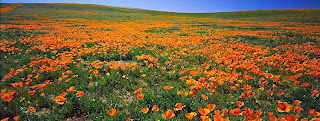The fascinating California poppies bloom all over the state, except the western side of Antelope Valley in northern Los Angeles County is the steadiest poppy-bearing land, protected from grazing and other human interference. Every spring, this desert like vicinity comes alive with millions of bright orange poppy flowers. The wildflower season normally lasts from as early as February through May, and also heavily depends on the amount of rainfall during the winter to early spring seasons. This region is now protected and called the Antelope Valley California Poppy Reserve. The Antelope Valley is situated in the western Mojave Desert at an elevation ranging from 2600--3000 feet, making it a high desert environment. Until the early 1970's sheep grazed the buttes, but park management has excluded sheep, and Pronghorn Antelope grazed long before then, but the railroad of the 1880's brought recreational hunters that abridged the numbers of the species to naught. Within the reserve, there is 11 kilometer of trails, as well as a paved section for wheelchair access, which traverse from side to side the poppy fields. Benches positioned along the trails make good places to sit quietly and look at for wildlife, such as singing meadow larks, lizards zipping across the trail, gopher snakes and rattlesnakes.
In order to keep the fields in a strictly natural state, California State Parks does not water or stimulate the flowers. The park service also excludes sheep and cattle from grazing the hillsides. Poppies aren’t the only wildflower growing in Antelope valley. Owl's clover, lupine, goldfield, cream cups, and coreopsis, to name a few, share the desert grassland to generate a mosaic of color and fragrance each spring. The Antelope Valley contains the western tip of the Mojave Desert, opening up to the Victor Valley and the Great Basin to the east. Lying north of the San Gabriel Mountains and southeast of the Tehachapis, this desert ecosystem spans about 5,698 km2. Precipitation in the surrounding mountain ranges contributes to groundwater recharge. As volatile as nature the intensity and duration of the wildflower bloom varies yearly.






























No comments:
Post a Comment